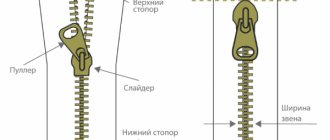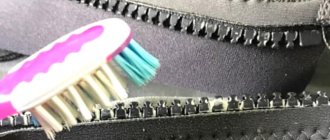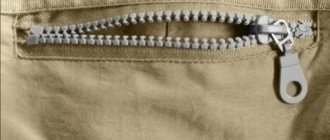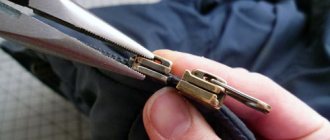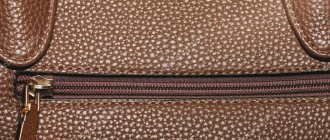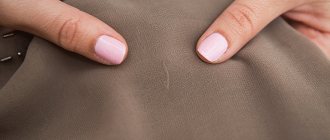Share on social media networks:
Each of us has probably experienced a broken zipper on our clothes. The situation can be easily corrected: by replacing it with a new one. But what to do if the zipper breaks and jams your trousers at the most inopportune moment? How to fix a zipper on jeans if it has come off and you are in a hurry and have no time to sew a new one? What should I do if I unzipped the zipper and the dog flew out? Use our recommendations to help solve the most common lock problems. So, let's go.
If fabric or threads are stuck in the zipper
Lock jamming is a very common problem that occurs mainly due to haste and careless movements when fastening. To remove fabric or stuck thread from a zipper, just pull the slider smoothly back and forth - wherever possible.
Important! Careful movements when pulling the fabric out of the lock will ensure its safety. If you show intolerance and try to release the zipper with sudden movements and jerks, the latter may fail.
Zipper slider doesn't move
If the carriage is stuck and cannot be moved in any direction, most likely some foreign object has gotten into it. In this case, we advise you to try to remove the slider from the lock using a tool and replace it with a new one. It is possible that you will still have to change the lock completely.
Important! The cause of the fastener sticking may also be due to the lack of lubricant, which helps the carriage slide over the teeth. The issue in this case is solved with the help of materials that will not leave stains on clothes: pencil lead, candles made of wax or paraffin.
A regular eraser will help keep your earring in place.
mashable.com
If you put on stud earrings and accidentally lost the screw clasp, do not rush to part with the jewelry here and now.
Cut a small piece from the eraser and use it instead of a fastener (temporarily, of course). see also
17 brilliant life hacks that will come in handy in any situation
The castle diverges
How to repair a zipper on jeans if the fly comes apart? Everything is simple here, since the reason lies in a weak slider. To fix the problem, take pliers in your hands and with a little force squeeze the carriage closer to the center.
You can also use a hammer. This option is less convenient, but when pliers are not at hand, a hammer may well save the situation
Important! Pressing the lock with pliers may damage it. It is important to calculate the effort, otherwise the lock may refuse to serve any longer if subjected to strong pressure.
Lightning parted in the middle
How to make a zipper on jeans if it has spread out in the middle? Such a mechanism definitely needs to be replaced, but if we are talking about repairs as a temporary measure, try connecting the lock teeth with your hands when fastening it. Then press the zipper with pliers to be sure. This tip will help you out if you are late and have no time to change clothes.
Important! If you sometimes have problems with different fasteners, also learn about how to install snaps on clothes.
The slider has broken loose and is dangling on one side of the lock.
In order to return the carriage to its place, we suggest:
- Cut the fabric between the teeth at the bottom of the lock so that you can attach the slider to the other side of the lock.
- Then you should move the slider down, put it in place and fasten the zipper.
- Now the zipper works, but to secure it and prevent the carriage from flying out again, the cut must be sewn up.
In the future, the lock will no longer be fully unfastened: the slider will only reach the cut point, but this is unlikely to affect the operation of the mechanism.
Important! Select threads that match the fabric of the lock so that traces of repair are not visually noticeable.
Her Majesty the Office Clip!
A colleague at work suggested this method to me. The principle is the same as with a pin, only a paper clip is used. I took a larger one with denser twigs.
The pin catches on the tongue of the dog.
And it is threaded through the button. The rods can be bent and adjusted.
Tip: when extended, the “tightness” of the paper clip is lost. Therefore, I recommend using as “strong” a paperclip as possible so that it does not loosen itself when moving!
The zipper on my jeans keeps coming undone
The zipper on your jeans comes undone - what to do if this problem constantly causes you inconvenience? Everything is as simple as that here:
- Take a round metal ring and attach it to the end of the slider. A ring from a keychain or a piece of wire from which you can make a loop is perfect. The main thing is that the diameter of the product allows you to put it on the button that is on the waistband of your trousers.
- With the zipper closed, place the ring on the button. This will provide you with confidence that the lock will not come undone and will not let you down in any situation.
Important! You can also use a thick thread as a “holder”, which must be secured to the slider in the form of a loop. If you decided on wire, consider the option of a colored coating that matches your trousers.
Video
Surely many of you have had a zipper break. The zipper is a popular fastener, especially the detachable zipper, which is convenient, but unfortunately, sometimes it breaks. And it is the part that breaks that is located below and that is inserted into the mating part, where it is fixed. What to do if you don’t want to change the lock, yes, sometimes it’s not so easy (it can be sewn very awkwardly), but you want to wear a jacket with a zipper. This happens especially often with children's jackets and sweaters. The children pull the zipper, they are in a hurry, and they tear the mechanism. In order not to throw away almost new children's clothes, parents simply sew up the bottom part of the lock and have to put the jacket on first over the head, like a sweater, and only then zip it up. But this is not only inconvenient, but also not very beautiful... You can’t send a child to school in such a jacket, especially when he is already a teenager.
So, you don't want to sew up the lock at the base and are unwilling (or unable) to replace it. Well... Then let's fix it.
First, we need a piece of iron from which we will make the part we need. We also need superglue and a paper clip. Superglue is one that hardens very quickly and becomes “like glass,” very hard (based on cyacrolate, sold in small tubes of 1-2 grams).
So, we remove all excess, after soaking the fabric with superglue. It will set quickly and add rigidity. Carefully cut with pliers. (photo 1).
Now comes the main part. We cut it to size from a piece of stainless steel or tinned tin (you can take it from a condensed milk can) and roll it up as shown in photo 2.
It should fit well into the part of the lock that moves and be well fixed in the part that is located below (photo 3). Next we manage to fasten the lock (photo 4). This can be done by hand connecting each clove in sequence. Surely, everyone did this when they were trying to understand how this thing works or when the lightning “spread” in the middle.
After this, we place our piece of iron on the inside of the lock and place it on superglue (photos 5 and 6). We try to unfasten it. If you did everything well, then the lock should come unfastened, although at first, until the piece of hardware gets used, this can be done with some effort. Take your time, because... the glue may not have time to set completely. So, you unfastened the lock. Everything works, but it's not enough.
Now we need to strengthen our structure. We drill 2 small holes and insert a bracket made from a regular paper clip (photo 7, 8,).
That's all now (photo 9, 10).
We finally check the operation of our lightning. For a better look, you can touch up the sizing areas with a permanent marker. For good performance, I recommend rubbing the lock with paraffin or stearin (a regular candle) or just soap.
Some useful tips related to zippers
If the zipper lock is a little tight, rub it with a stearin candle. This advice is especially effective for metal zippers. A soft pencil lead will also help. It is enough to pass it along the zipper several times.
If the zipper often spontaneously diverges in the middle, lightly tap the lock (its edges, and not the bracket to which the tongue is attached) with a small hammer.
Tapping the zipper itself, if it is metal, will also help.
The lock will become tighter, but the zipper will stop moving apart.
If the tab on the zipper comes off, it can be replaced with a regular paper clip.
If the zipper on your trousers tends to undo itself, thread a small key ring through the zipper tab and place it over the button of your trouser waistband. Such a ring can also be made from a paper clip.
Zippers on shoes suffer greatly from dampness, wet and salty snow, and slush. Which dramatically reduces their service life. Rub a piece of unsalted lard over them or use a special hydrophobic lubricant more often. And the lightning will be protected from dampness. Such lubrication will also improve its performance.
So the zipper is stuck and won't go down, and you're trapped by your item because you have to unzip it to get it off.
Take a regular pencil with a graphite tip and rub it over the teeth of the zipper. This should help. If not, you need to increase the glide, such as rubbing the teeth with soap, lip balm or detergent that reduces friction.
Using a Q-tip, apply lubricant to the zipper and teeth. Then pull the fastener down and repeat the lubrication procedure again. Continue until the clasp is completely undone.
The teeth have fallen out of the zipper - how to repair it?
How to fix a lock on jeans if it has “lost” several teeth? Please note that this failure is serious and requires replacement of the mechanism.
But if you have enough patience, we suggest trying to repair the zipper so as not to rip out the entire lock and sew in a new one. For this:
- You need to buy a lock with suitable teeth in thickness and height.
- Remove the required number of teeth from it. For “tractor” locks, they are usually easy to remove.
- To transfer the clove to the zipper, take a piece of copper foil.
- Then open the clove that needs to be secured to the lock, place it first on a strip of foil, and then move it to the fabric.
- Install subsequent ones using the same technology.
You can secure the result using stitches between the “new” teeth. The castle is ready for use again!
Prevention
To avoid problems with zippers on shoes in the future, you must use the following recommendations:
- Clean the fastener links periodically. Treatment with wax or paraffin is required.
- Use an old toothbrush to periodically clean the lock.
- To prevent the lock from coming apart, it is secured with a thick thread.
Read also: Lightning protection down conductors
To prevent the fastener from coming apart, you should carefully choose your shoes. It's best to try on a pair before purchasing. It is important that it is comfortable and fits properly.
Boot zippers come apart for a variety of reasons. In many cases, the defect is easy to fix yourself. And if this cannot be done, it is better to take the shoes to a specialist.
Gromova Anna, professional in the shoe business. Owner of a small store and shoe restoration and repair workshop.
The zipper teeth are damaged
How to repair a zipper on jeans if the teeth remain in place, but are damaged or deformed, as a result of which the carriage does not fit in this place?
You're lucky if the damage occurs in the lower part of the lock: it can be fixed, although not for long. Usually the lock deteriorates in this place. You can correct the situation with the help of threads.
To do this, you should make a tack from them above the damaged area. Thus, the slider will only reach the thread patch, but the lock will still remain capable of performing its functions.
Loop
You can also fix the latch using a homemade loop. Take a string (I used a ribbon) and thread it through the hole in the dog
Next, we make a turn around the base of the button, tie it with 2 knots, and trim off the excess edges. It turns out to be a loop.
Note! The loop should be the optimal width so that the button can easily fit through it.
You can't see anything under the button! To prevent the knot from constantly untying, it is worth making 2 strong knots, not a bow. Also, elastic bands or laces or elastic material are not suitable for this method. There is a risk of stretching and then the loop will not perform its function.
How to repair a zipper on jeans with your own hands?
If the mechanism that connects the two sides of the zipper breaks down, the lock must be replaced. How to fix the lock on jeans yourself if the carriage is broken? To do this, you need to have a sewing machine and basic sewing skills:
- The most difficult thing is to free the lower part of the lock from numerous lines. In addition, getting to the zipper on jeans is not so easy, you will have to be patient.
- Once you've flogged the bottom of the zipper, carefully release the zipper edges from the stopper by pushing the zipper rivets apart.
- Then remove the broken carriage and insert a new one.
Important! You should put on the new slider carefully, starting from the first teeth of the zipper.
- Slide the carriage over the lock, closing it.
- Turn the product inside out and secure the stopper above the place where the zipper teeth end.
- Using a sewing machine, sew a lock at the bottom of the codpiece using threads that match the color and thickness.
Important! Also read about how to put a button on jeans.
That's all - the castle has been updated and is ready to continue working!
Correct fit of jeans - what is it like?
Two important rules to follow when adding a pair of jeans to your wardrobe are to take into account the type, strengths and weaknesses of your figure and choose the size wisely. Without taking these parameters into account, jeans will not fit well, namely, they will bunch up at the knees, at the back, in the groin, sag, etc. Let's see what popular jeans models are suitable for owners of different body types:
- Tight or skinny. This model lengthens the legs and emphasizes the hips. Suitable for triangle, rectangle and hourglass body types.
- Semi-loose or classic. They hide extra pounds and do not draw attention to “problem” areas - a full tummy, waist, hips. This is a good choice for ladies with a triangle figure - regular and inverted, hourglass, circle. Women with a rectangle figure should not choose this model.
- Spacious or boyfriends. They hide leg imperfections, emphasize the waist, and disguise narrow hips. Bad choice for "triangle" and "circle".
- High waisted. They make the legs visually longer, “narrow” the waist, mask folds in this area, but at the same time reduce height. Suitable for rectangle, hourglass and circle. Wrong choice for triangle.
- With a classic waist. They hide folds in this area, while making the waist “inexpressive”. Ladies with a rectangle and inverted triangle body type should not choose these jeans.
- Low waist. They lengthen the torso and accentuate the waist area. Disadvantages: emphasize flaws in the abdominal area, shorten the legs. Not suitable for circle and triangle shapes.
- Tapered. Makes the hips more rounded. Not suitable for ladies with curvy figures.
- Straight cut bottom leg. Masks leg imperfections. Suitable for ladies with almost any figure, except for the “inverted triangle” type.
- Knee flare. Reduces the volume of the upper torso, making the figure proportional. Not suitable for short people.
- Flare from the hip. Masks leg imperfections. The best option for ladies with curvy figures. Not suitable for "rectangle" and "triangle".
If you don't know what body type you have, here's a little cheat sheet to help:
- the chest and hips are equal in volume, and the waist is “noticeably” smaller - it’s an “hourglass”;
- with approximately the same chest and hips and an undefined waist, the figure type is called “rectangle”;
- if the chest is noticeably smaller in volume than the hips, and the waist is pronounced, then these are signs of a “triangle” or “pear” figure;
- accordingly, with an “inverted triangle” the opposite is true.
- if the parameters under consideration - chest, waist, hips - are approximately the same in volume, then this is the “circle” type.
Equally important when choosing a pair of jeans is to choose the right size. A small one will lead to the fact that when fastening the fly, the sides and stomach will simply “fall over” the edge of the clothing, a large one will “threaten” with the appearance of folds in the groin or under the buttocks, as well as the so-called “accordion” at the bottom of the legs.




